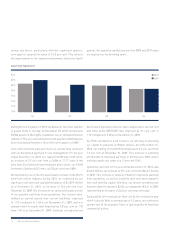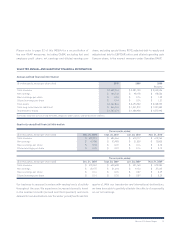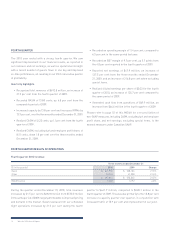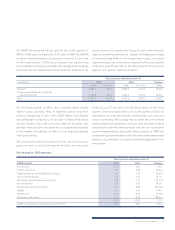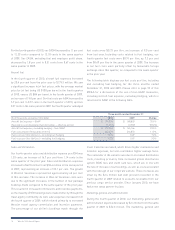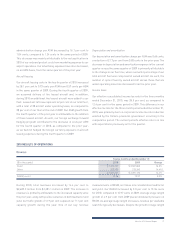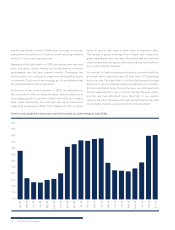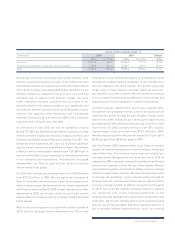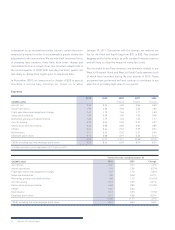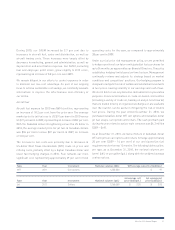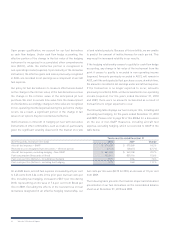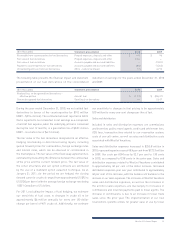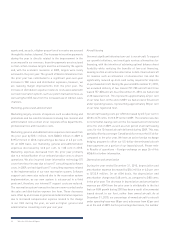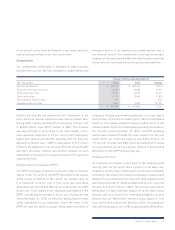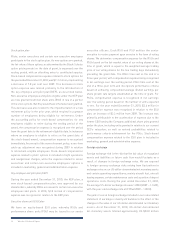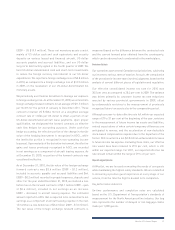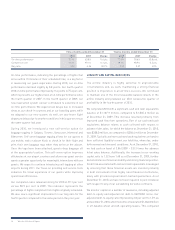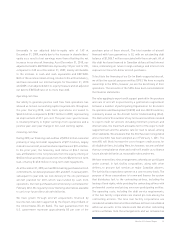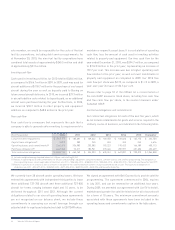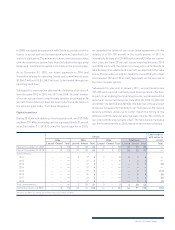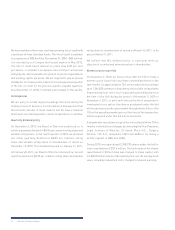Westjet 2010 Annual Report Download - page 24
Download and view the complete annual report
Please find page 24 of the 2010 Westjet annual report below. You can navigate through the pages in the report by either clicking on the pages listed below, or by using the keyword search tool below to find specific information within the annual report.
22 WestJet 2010 Annual Report
Upon proper qualification, we account for our fuel derivatives
as cash flow hedges. Under cash flow hedge accounting, the
effective portion of the change in the fair value of the hedging
instrument is recognized in accumulated other comprehensive
loss (AOCL), while the ineffective portion is recognized in
non-operating income (expense). Upon maturity of the derivative
instrument, the effective gains and losses previously recognized
in AOCL are recorded in net earnings as a component of aircraft
fuel expense.
Our policy for fuel derivatives is to measure effectiveness based
on the change in the intrinsic value of the fuel derivatives versus
the change in the intrinsic value of the anticipated jet fuel
purchase. We elect to exclude time value from the measurement
of effectiveness; accordingly, changes in time value are recognized
in non-operating income (expense) during the period the change
occurs. As a result, a significant portion of the change in fair
value of our options may be recorded as ineffective.
Ineffectiveness is inherent in hedging jet fuel with derivative
instruments in other commodities, such as crude oil, particularly
given the significant volatility observed in the market on crude
oil and related products. Because of this volatility, we are unable
to predict the amount of ineffectiveness for each period. This
may result in increased volatility in our results.
If the hedging relationship ceases to qualify for cash flow hedge
accounting, any change in fair value of the instrument from the
point it ceases to qualify is recorded in non-operating income
(expense). Amounts previously recorded in AOCL will remain in
AOCL until the anticipated jet fuel purchase occurs, at which time,
the amount is recorded in net earnings under aircraft fuel expense
.
If the transaction is no longer expected to occur, amounts
previously recorded in AOCL will be reclassified to non-operating
income (expense). For the years ended December 31, 2010
and 2009, there were no amounts reclassified as a result of
transactions no longer expected to occur.
The following table displays our fuel costs per litre, including and
excluding fuel hedging, for the years ended December 31, 2010
and 2009. Please refer to page 52 of this MD&A for a discussion
on the use of non-GAAP measures, including aircraft fuel
expense, excluding hedging, which is reconciled to GAAP in the
table below.
On an ASM basis, aircraft fuel expense increased by 6.5 per cent
to 3.45 cents from 3.24 cents in the prior year. Our fuel costs per
litre, including fuel hedging, increased to $0.71 per litre during
2010, representing an increase of 7.6 per cent from $0.66 per
litre in 2009. Excluding the effects of the realized loss on fuel
derivatives designated in an effective hedging relationship, our
fuel costs per litre were $0.70 for 2010, an increase of 11.1 per cent
from 2009.
The following table presents the financial impact and statement
presentation of our fuel derivatives on the consolidated balance
sheet as at December 31, 2010 and 2009.
Twelve months ended December 31
($ in thousands, except per litre data) 2010 2009 Change
Aircraft fuel expense – GAAP $ 674,608 $ 570,569 18.2%
Realized loss on designated fuel derivatives – effective portion (9,172) (28,411) (67.7%)
Aircraft fuel expense, excluding hedging – Non-GAAP $ 665,436 $ 542,158 22.7%
Fuel consumption (thousands of litres) 950,341 859,116 10.6%
Fuel costs per litre (dollars) – including fuel hedging 0.71 0.66 7.6%
Fuel costs per litre (dollars) – excluding fuel hedging 0.70 0.63 11.1%


